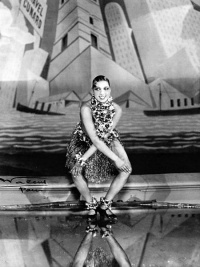France–United States relations
From The Art and Popular Culture Encyclopedia
| Revision as of 22:08, 6 February 2008 Jahsonic (Talk | contribs) ← Previous diff |
Revision as of 22:17, 6 February 2008 Jahsonic (Talk | contribs) Next diff → |
||
| Line 1: | Line 1: | ||
| + | [[Image:Josephine Baker dancing the Charleston to an Art Deco-styole background.jpg|thumb|right|200px|[[Josephine Baker]] dancing the [[charleston]] at the [[Folies Bergère]] in Paris for ''[[La Revue nègre]]'' in [[1926]]. Notice the [[art deco]] background. <br>(Photo by Walery)]] | ||
| {{Template}} | {{Template}} | ||
| '''Franco-American relations''' refers to [[interstate relations]] between the [[France|French Republic]] and the [[United States|United States of America]]. Its groundwork was laid by the [[European colonization of the Americas|colonization]] of parts of the [[Americas]] by the [[Europe]]an [[power (international)|powers]] [[French colonization of the Americas|France]] and [[British colonization of the Americas|Great Britain]]. | '''Franco-American relations''' refers to [[interstate relations]] between the [[France|French Republic]] and the [[United States|United States of America]]. Its groundwork was laid by the [[European colonization of the Americas|colonization]] of parts of the [[Americas]] by the [[Europe]]an [[power (international)|powers]] [[French colonization of the Americas|France]] and [[British colonization of the Americas|Great Britain]]. | ||
Revision as of 22:17, 6 February 2008

(Photo by Walery)
|
Related e |
|
Featured: |
Franco-American relations refers to interstate relations between the French Republic and the United States of America. Its groundwork was laid by the colonization of parts of the Americas by the European powers France and Great Britain.
Interwar years
During the interwar years, the two nations remained friendly. Beginning in the 1920s, U.S. intellectuals, painters, writers, and tourists were drawn to French art, literature, philosophy, theatre, cinema, fashion, wines, and cuisine. A number of American artists, such as Josephine Baker, had successes in France. Paris was also quite welcoming to Jazz music and black artists — since France, contrary to a significant part of the U.S. at the time, had no racial discrimination laws. U.S. novelists such as William Faulkner and numerous filmmakers influenced French life.
Postwar years
While occasional tensions surfaced between the governments, the French public, except for the Communists, generally had a good opinion of the United States throughout the 1950s and into the 1960s. Despite some degree of cultural friction, the United States were seen as a benevolent giant, the land of modernity, and the French youth took a taste to things American such as chewing gum, Coca-Cola, and rock'n'roll.

